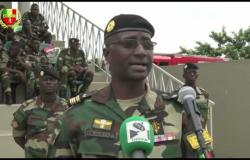Several Iranian media announced, Monday morning, May 20, the death of President Ebrahim Raïssi and the Minister of Foreign Affairs, Hossein Amir Abdollahian, in the crash the day before of their helicopter in the north-west of Iran. “The president of the Iranian people, hardworking and tireless, (…) sacrificed his life for the nation”the Iranian government confirmed in the morning. “We assure the loyal nation that with the help of God and the support of the people, there will not be the slightest disruption in the administration of the country”he added in a press release.
The information was initially given by the Mehr agency and the government newspaper Iran Daily, after the discovery of the wreckage of the helicopter at dawn. The television broadcast religious songs on Monday morning and showed photos of the president. “The great spirit of the popular and revolutionary president of Iran has joined the supreme kingdom”declared the official IRNA agency, welcoming ” the martyr “ the victims.
“Harsh landing” and intense searches
According to the authorities, the helicopter carrying the Iranian president and the foreign minister had to make a “hard landing”, in emergency, in a mountainous and rural area near the border between Iran and Azerbaijan, Sunday. The emergency services had great difficulty reaching the place where the plane crashed, even though the weather was very cloudy, according to the first images of the operation broadcast by the Fars press agency, and the night was fell on the region.


Supreme Leader Ali Khamenei called on Iranians to pray for “ health “ of President Raïssi. “We hope that Almighty God will protect the honorable president and his companions” he added, during a public speech in Tehran.
Ebrahim Raïssi met his counterpart Ilham Aliev on Sunday morning on the occasion of the inauguration of a dam on the Araxe river, near the Iranian prefecture of Khoda Afarin, along the border with Azerbaijan.
On the return trip, as the convoy headed toward the city of Tabriz, where the president was to visit an oil refinery, one of the planes carried out a “hard landing” urgently, according to several media, including Tasnim News and Jam Jam Online. The two other helicopters in the presidential convoy were able to continue their journey without incident. The Minister of the Interior, Ahmad Vahidi, confirmed these first elements on television.
Intense research had been carried out. The IRNA agency specified that “more than twenty rescue teams equipped with full equipment, in particular drones and rescue dogs”had “were sent there”. However, the drones used, as well as a helicopter sent as reinforcement, were initially unable to access the accident area due to bad weather.
Difficult weather conditions
In addition to Ebrahim Raïssi, the presence of the Minister of Foreign Affairs, Hossein Amir Abdollahian and the governor of the East Azerbaijan region, Malik Rahmati, as well as several other people in the helicopter, was mentioned by several Iranian media.
The Fars news agency relayed, on Sunday afternoon, the first calls to prayer for the Iranian president in the town of Mashhad, Raisi’s hometown, in the east of the country. These scenes of prayers on public roads have multiplied in several cities across the country. Some television channels have changed their programs to follow the difficult developments in relief efforts.

The vice-president, Mohammad Mokhber, left Tehran late in the afternoon to reach Tabriz in the company of several ministers, according to the government spokesperson. It is he who is supposed to take over as president, pending the holding of a presidential election within fifty days.
International aid
Azerbaijani President Ilham Aliyev, whom President Raisi had visited a few hours earlier, offered his aid to Iran on Sunday. Turkish President Recep Tayyip Erdogan spoke https://twitter.com/RTErdogan/status/1792252450927251931 “deeply saddened” by the helicopter accident of Iranian President Ebrahim Raïssi, and offered “all the support needed” to research. Turkey announced that it had deployed 32 rescuers and several vehicles, including a helicopter equipped for night searches.
The World Application
The Morning of the World
Every morning, find our selection of 20 articles not to be missed
Download the app
Russia announced on Sunday evening that it had sent a team of around fifty rescuers as well as a helicopter and several all-terrain vehicles to the region of the accident.. Quoted by the Iranian media Fars News, Vladimir Putin’s advisor, Igor Levitin, expressed “worry” of the Russian president.
Saudi Arabia, Iran’s regional rival, had reported https://twitter.com/KSAmofaEN/status/1792251321816350770 of his “great concern” after the disappearance of the plane carrying the Iranian president, offering his help to Iran to find him. For its part, the European Union announced that it had activated its Copernicus satellite mapping system to help Iran find the device.
An ultraconservative figure
Always wearing a black turban and dressed in a religious cloak, the Iranian president has led Iran since 2021 in a context of trouble abroad and internal protest. Aged 63, Ayatollah Raïssi was considered an ultraconservative and an outspoken supporter of order.
Also read our story: Article reserved for our subscribers Ebrahim Raïssi and the Revolutionary Guards, the two implacable cogs of Iranian repression
Add to your selections
Born in November 1960, Mr. Raïssi had climbed the ranks of the judicial system for three decades, after being appointed prosecutor general of Karaj, near Tehran, at just 20 years old, in the wake of the victory of the Islamic revolution of 1979. He was then prosecutor general of Tehran from 1989 to 1994, then deputy head of the judicial authority from 2004 to 2014, the year of his appointment as prosecutor general of the country.
In 2016, Supreme Guide Ali Khamenei placed him at the head of the powerful charitable foundation Astan-e Quds Razavi, which manages the mausoleum of Imam-Reza in Mashhad as well as an immense industrial and real estate heritage. Three years later, he took over as head of the judicial authority.
Having presented himself as the champion of the disadvantaged classes and the fight against corruption, Mr. Raïssi was elected on June 18, 2021 in the first round of a vote marked by an unprecedented abstention for a presidential election, and the absence of strong competitors. He succeeded the moderate Hassan Rouhani, who beat him in the 2017 presidential election and could no longer run again after two consecutive terms.
Troubled context and internal dispute
Mr. Raïssi emerged strengthened from the legislative elections held in March and mid-May, the first national election since the protest movement which shook Iran at the end of 2022 following the death of Mahsa Amini, a young woman arrested for failing to comply with the Islamic Republic’s strict dress code.
The Iranian president then welcomed“a new historic failure inflicted on Iran’s enemies after the riots” of 2022. Parliament, which will take office on May 27, will be largely under the control of the conservative and ultraconservative camps, which support his government.
In recent months, Mr. Raïssi had presented himself as a resolute adversary of Israel, the sworn enemy of the Islamic Republic, by providing his support to the Palestinian Islamist movement Hamas since the start, on October 7, of the war that Israel delivers him to the Gaza Strip.

He thus justified the unprecedented attack launched by Iran on April 13 against Israel, with 350 drones and missiles, most of which were intercepted with the help of the United States and several other allied countries. Mr. Raïssi was on the American blacklist of Iranian officials sanctioned for “complicity in serious human rights violations”accusations dismissed as null and void by the authorities in Tehran.
Read also | Article reserved for our subscribers Iran welcomes attacks on Israel, vows ‘fiercer response’ in case of retaliation
Add to your selections










